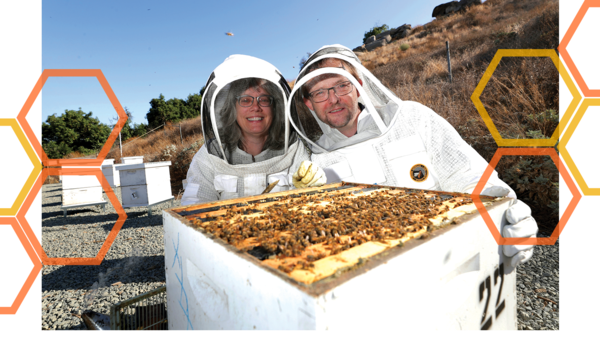If you think blueberries, cherries, or almonds are expensive, wait until you buy cranberries for Thanksgiving this year. They’re about to get much pricier, if you can get them at all. All of them are dependent on pollination by bees, as are about a third of the foods we put in our mouths. If honeybee colonies continue to die off at the current rate, much of our food supply will become extremely costly or cease to be produced in large quantities. Researchers report about 40% of U.S. honeybee colonies died between October 2018 and April 2019 — the highest winter loss in 13 years. This follows a pattern of decline. In 1947, the U.S. was home to 6 million honeybee colonies. Today, the number is less than half that amount, and it continues to drop.
To help stop this troubling trend, UC Riverside is developing an electronic early warning system to let beekeepers know when their hives aren’t healthy. This “robotic veterinarian” features first-of-its-kind technology, small sensors that will “smell’ and “hear” early signs of distress inside the hives. Though several sensor-based platforms for colony monitoring are already available, they all suffer from substantial shortfalls. Most of them only measure nonspecific variables such as temperature, carbon dioxide fluctuations, or colony weight. Such simple measurements don’t give beekeepers specific information about what might be wrong with their bees, or how to help them, according to UCR entomologist Boris Baer, who is leading the team developing this new technology.
“A fever on its own isn’t likely to tell a doctor what you have,” explained Baer, a professor of entomology and principal investigator for UCR’s Center for Integrative Bee Research. “There are multiple other indicators needed to determine what illness is causing the fever and what the right course of treatment should be. The same is true of a beehive.”
Scientists attribute colony collapses to a number of factors, including habitat destruction, pesticide exposure, parasites, pathogens, and climatic changes. The robotic vets will help beekeepers disentangle which of the stressors may be occurring in their hives. Sick bees smell different than healthy ones, and bees emit chemicals when they become infected with a pathogen or parasite. One such chemical, a so-called “suicide pheromone,” tells other bees that the diseased individual needs to be removed from the hive. Queens have a signature smell that diminishes when they’re stressed or when they die, and yet another scent can indicate hunger.
These scents are molecules that a sensor placed inside a hive can detect. Then, software can analyze and identify the molecules, and artificial intelligence can be trained to compare them with chemicals present in healthy beehives. The UCR team, which also includes Baer’s wife, pollination specialist Barbara Baer-Imhoof, has already identified a number of these molecules, collected five years’ worth of data from beehives, and is now working on building and testing prototypes. Baer believes the device will represent a quantum leap forward in protecting honeybees because it offers early indications of what’s wrong with a hive while it’s still treatable.
“Just as when a human has very late stage cancer, it’s likely considered too difficult to treat,” Baer said. “If we have a colony that collapses, it’s also too late.”

This work was enabled by a $25,000 grant from the Frank G. and Janice B. Delfino Agricultural Initiative. The grant was set up to encourage collaboration between UCR’s College of Natural and Agricultural Sciences and the Marlan and Rosemary Bourns College of Engineering. Philanthropic funding is crucial for helping turn big ideas such as this one into big realities. Baer explains that some research funders might initially find a project like this one too complicated or risky.
“It’s a long-term project involving individual bee biology, the behavior of an entire hive, and complicated technology,” Baer said. “There are a lot of moving parts. But if you really want to make a breakthrough, you have to be ambitious and take some risks.”
The grant allowed the development team to gather pilot data and establish proof of concept, which helped the researchers win $900,000 in further funding this year from the University of California’s Office of the President. This second grant establishes a network of bee researchers at four UC campuses — Riverside, Merced, Davis, and San Diego — who are boosting honeybee health using several strategies, including this new sensing tool. The Federal Emergency Management Agency has also funded part of the project, and further large-scale research grants, as well as funding from beekeeping and pollination-dependent organizations is likely. None of this success would have been possible without the initial seed money from the Delfino initiative.
“It’s the seed that helped us leverage up,” Baer said. “It was the first domino piece to fall, and we couldn’t be more grateful for that.”
For Baer, this project has personal and professional reverberations.
“I’ve worked with bees my whole career, my entire family keeps bees, and watching their decline has been heartbreaking,” Baer said. “This technology is so exciting to me because it represents the potential for a real breakthrough in the fight to save these insects I love, and to keep food affordable.”